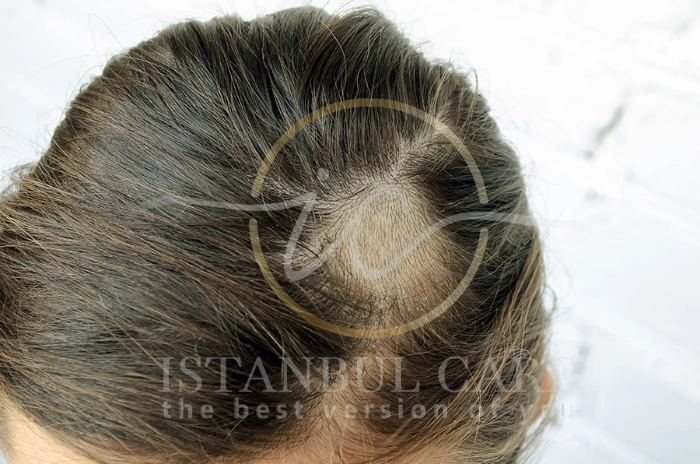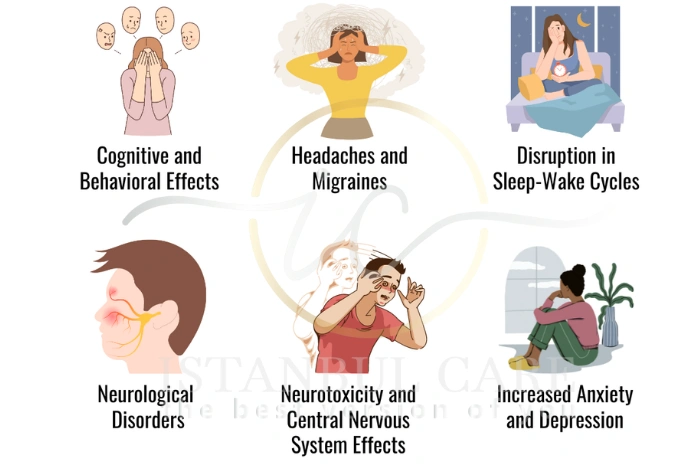Hair loss can be devastating, especially when the cause remains mysterious. Many people never consider that mold exposure might be the hidden culprit behind their thinning hair. The connection between mold and hair loss is real and more common than most realize.
Can mold cause hair loss? The answer is yes. Exposure to toxic mold, particularly black mold, can trigger various forms of hair loss through inflammation, immune system disruption, and hormonal imbalances. Understanding this connection is crucial for anyone experiencing unexplained hair thinning in moldy environments.

Hair Loss and Mold Toxicity: What’s the Link?
The relationship between toxic mold syndrome and hair loss involves multiple biological pathways. When you’re exposed to mold spores and mycotoxins, your body launches a complex response that can inadvertently target hair follicles.
Chronic Inflammation from Mold Spores
Mold spores trigger chronic inflammation throughout the body, including the scalp. This persistent inflammatory state disrupts normal hair growth cycles and weakens hair follicles. The inflammatory response can cause follicles to enter the resting phase prematurely.
Inflammatory cytokines released during mold exposure create an environment hostile to healthy hair growth. These molecules interfere with the normal cellular processes required for strong, thick hair production.
Immune System Disruption and Autoimmune Hair Loss
Mold exposure can cause immune system dysfunction, sometimes triggering autoimmune responses where the body attacks its own hair follicles. This immune system mold hair loss mechanism resembles conditions like alopecia areata.
The immune system becomes hyperactive when constantly fighting mold toxins, potentially misidentifying hair follicle proteins as foreign invaders.
Hormone Imbalance from Mold Exposure
Mycotoxins can disrupt the endocrine system, affecting hormones crucial for hair growth. Thyroid function, cortisol levels, and sex hormones can all be impacted by chronic mold exposure.
Mycotoxins and Weakened Hair Follicles
Mycotoxins and hair loss are directly connected through cellular damage. These toxic compounds produced by certain molds can penetrate hair follicles and damage the cellular machinery responsible for hair production.
Nutrient Deficiencies Caused by Mold Damage
Mold illness often leads to digestive issues and malabsorption, creating deficiencies in nutrients essential for hair health. Biotin, zinc, and iron deficiencies are common in people with chronic mold exposure.
Black Mold and Hair Loss: Key Symptoms to Watch For
Black mold hair loss often presents with specific patterns and accompanying symptoms that distinguish it from other causes of hair thinning.
| Mold Exposure Symptoms | Hair-Related Signs | Timeline |
|---|---|---|
| Chronic fatigue | Diffuse hair thinning | 2-3 months after exposure |
| Headaches | Increased shedding | Progressive worsening |
| Respiratory issues | Brittle, dry hair | Gradual onset |
| Scalp irritation | Hair breakage | Corresponds with exposure |
| Skin sensitivity | Reduced hair density | Accelerates over time |
Common Signs of Mold-Related Hair Thinning
Black mold hair thinning typically manifests as diffuse hair loss rather than distinct bald patches. You may notice increased hair in your shower drain, on your pillow, or when brushing your hair.
Other Health Symptoms Linked to Mold Exposure
Symptoms of mold exposure extend beyond hair loss and often include chronic fatigue, headaches, respiratory issues, and cognitive problems. Many people experience symptoms that improve when they leave the moldy environment.
How Hair Growth Cycles Are Changed by Mold
Understanding how mold affects hair growth requires knowledge of how toxins disrupt the normal hair growth process.
Mold Toxins and Their Effect on Scalp Health
Mycotoxin hair loss occurs when these toxic compounds accumulate in scalp tissues. The scalp becomes inflamed and less able to support healthy hair follicles.
Inflammation: The Hidden Cause of Mold-Induced Hair Loss
Inflammation from mold is often the primary mechanism driving hair loss. Chronic inflammation disrupts the delicate balance of growth factors that regulate hair cycles.
Treating Hair Loss Caused by Mold Exposure
Treating hair loss from mold requires a comprehensive approach addressing both the underlying mold exposure and supporting hair regrowth.
Medical Solutions for Mold-Related Hair Thinning
Medical treatment for mold toxicity hair loss often involves detoxification protocols, anti-inflammatory medications, and specific treatments for hair regrowth. Some doctors prescribe antifungal medications to address systemic mold infections.
Natural Remedies to Restore Hair After Mold Illness
Natural approaches to mold illness recovery include supporting detoxification pathways, reducing inflammation through diet, and providing targeted nutrition for hair health. Supplements containing biotin, zinc, and iron can help restore deficiencies.
Preventing Mold-Induced Hair Loss: Practical Tips
Preventing mold-induced alopecia starts with controlling your environment and supporting your body’s natural defenses against mold toxins.
How to Reduce Mold in Your Living Environment
Environmental mold control involves identifying and eliminating moisture sources, improving ventilation, and using dehumidifiers. Professional mold remediation may be necessary for severe infestations.
Diet and Lifestyle Changes to Protect Hair from Mold
Anti-inflammatory diets rich in antioxidants help combat the oxidative stress caused by mold exposure. Foods high in sulfur support detoxification pathways essential for recovery.
Telogen Effluvium and Mold Exposure
Mold telogen effluvium is a specific type of hair loss where chronic stress from mold exposure pushes hair follicles into the resting phase.
Why Mold Can Cause Increased Hair Shedding
The stress response triggered by chronic mold exposure elevates cortisol levels, which can cause widespread hair shedding. This type of hair loss typically occurs 2-3 months after significant mold exposure begins.

Signs of Mold Exposure That Can Affect Hair
Recognizing mold illness symptoms early can help prevent severe hair loss and other health complications.
Symptoms Like Fatigue, Headaches, or Scalp Irritation
Mold illness symptoms often begin subtly with fatigue, headaches, and respiratory issues. Scalp irritation, itching, or sensitivity may precede noticeable hair loss.
Musty Odor or Mold Growth as Warning Signs
Environmental signs like musty odors, visible mold growth, or water damage indicate potential exposure risks. Taking action when these warning signs appear can prevent chronic health issues.
How to Recover Hair After Mold Exposure
Mold illness recovery requires patience and a systematic approach to healing both the body and hair follicles.
Removing Mold to Stop Further Hair Loss
The first step in recovery is eliminating ongoing mold exposure. This may require moving to a mold-free environment or professional remediation of your current space.
Scalp Care and Hydration for Hair Regrowth
Gentle scalp care helps create optimal conditions for new hair growth. Using mild, sulfate-free shampoos protects vulnerable recovering follicles.
Supporting Immune and Hormonal Balance
Recovery involves rebalancing the immune system and hormones disrupted by mold exposure. Stress reduction techniques and adequate sleep help restore normal hormonal patterns.
Nutrients Essential for Hair Recovery
Biotin, zinc, iron, and hair health are closely linked, making targeted supplementation crucial during recovery. B-vitamins, vitamin D, and omega-3 fatty acids support overall hair health.
How Mold Affects Your Immune System and Hair
The immune system mold hair loss connection involves complex interactions between immune responses and hair follicle function.
When Your Immune Response Attacks Hair Follicles
Chronic mold exposure can trigger autoimmune responses where activated immune cells mistakenly target hair follicles. The molecular mimicry between mold proteins and hair follicle components may contribute to this response.
Mold and Immune Overdrive Leading to Autoimmune Shedding
Persistent immune activation from mold exposure can lead to a hyperactive immune state that attacks healthy tissues, including hair follicles. This often improves when mold exposure ends.
Root Causes of Hair Loss from Mold
Understanding the root causes of hair loss from mold exposure helps guide effective treatment strategies.
Inflammation as a Hidden Trigger
Inflammation from mold creates a cascade of effects that disrupt normal hair growth. This chronic inflammatory state is often the primary driver of hair loss in mold-exposed individuals.
Hormonal Changes Linked to Mold Exposure
Mold toxins can disrupt multiple hormone systems, affecting thyroid function, adrenal hormones, and sex hormones all important for hair health.
Mitochondrial Damage and Hair Follicle Stress
Mycotoxins can damage mitochondria within hair follicle cells, reducing energy production needed for hair growth. Supporting mitochondrial health through targeted nutrients may help restore function.
Speak with our expert Hair Transplantation specialists

Speak with our expert Hair Transplantation specialists
We’re ready to answer your questions
FAQs for Can Mold Cause Hair Loss? Everything You Need to Know
Yes, mold exposure can directly cause hair loss through inflammation, immune system disruption, and hormonal imbalances that affect hair follicles.
Mold telogen effluvium is the most common type, characterized by diffuse hair thinning and increased shedding rather than patchy bald spots.
Mold affects hair growth by forcing follicles into the resting phase prematurely and disrupting the normal timing of growth cycles.
Key symptoms include increased hair shedding, diffuse thinning, brittle hair, and scalp irritation alongside other mold illness symptoms like fatigue and headaches.
The immune system mold hair loss connection occurs when chronic activation leads to autoimmune responses that target hair follicles.
Mycotoxins and hair loss are linked through direct cellular damage to hair follicles and disruption of normal growth processes.
Treating hair loss from mold requires eliminating mold exposure, supporting detoxification, reducing inflammation, and providing targeted nutrients for hair health.
Hair regrowth typically begins 3-6 months after successful treatment of mold exposure, with full recovery taking 12-18 months depending on severity.

